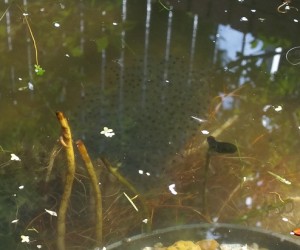Not all Tadpoles are the Same (Observing Tadpoles in our Unique Office Pond)
Differences in Tadpoles – Trying not to get Caught Out by Anthropomorphism
The weekend has brought a number of staff members into the Everything Dinosaur offices, to do the various chores that we have been assigned. However, we still get plenty of time to sit outside in the sun during our coffee breaks and to observe the many hundreds of tadpoles in the office pond. As Sir David Attenborough observed in his latest episode of the excellent Radio 4 series “Life Stories”, some animals are easier to distinguish from others of their species. Humpback whales for example, when they dive, their large, crescent shaped tail flukes often rise clear of the water. The undersides of these tails are white with black markings. Each whale has distinct tail markings and when these are photographed they can be used to help identify that individual whale if it is spotted in the future. From these simple observations scientists have been able to build up a comprehensive picture of the voyages made by individual whales of different species.
Looking for differences in our tadpole population is somewhat more tricky, but not impossible. Although the animals were hatched within just a few days of each other their variation is remarkable and in only a few minutes, a number of identifying characteristics can be determined. For example, at first glance the tadpoles all seem to be the same colour, but this is not so, some are darker than others, some are black, some are more a shade of brown.
Not All Tadpoles Are The Same
Picture credit: Everything Dinosaur
Tadpoles
The tadpoles are all the same species – The Common Frog (Rana temporaria), but even after two weeks differences can be observed in the population. Identifying individuals without intruding too much (by marking them for example), is complicated by these animal’s rapid growth rate, after all, those that survive will undergo a dramatic metamorphosis in a few weeks. But certainly, differences between individuals in terms of their size, growth rate, colouration, body length, degree of fluking on the tail can all be made out.
Genetically, all these tadpoles will be slightly different – this is a result of the way in which they were produced – with two parents providing genetic material to the offspring. Although, we wish to try to avoid being accused of anthropomorphism individuals may have different behaviours. It might be too much to regard these as different personalities and to label tadpoles as introverts and extroverts as individuals may behave in contrasting ways to others of their kind. For instance, those tadpoles that are the strongest swimmers have been observed swimming across open stretches of water, perhaps seeking food resources that they can exploit. Other tadpoles, not as well developed as their siblings remain in the same part of the pond for long periods. Their growth may be restricted as they are less mobile and therefore less able to find food than some of their counterparts.
Interestingly, mobility in tadpoles residing in our office pond was in previous years we suspect, likely to lead to those tadpoles actively swimming in open water to be predated upon. There used to be a population of water boatman in the pond. These aggressive invertebrates would attack and eat any tadpoles that they could catch. As the water boatman were nektonic (swimming actively in the water column), they were more likely to predate those tadpoles that ventured into open water without cover. This year, however, we have not observed a single water boatman in the pond. We suspect that the cold winter killed off our population. There is now an absence of nektonic predators of tadpoles in the pond. The removal of a predator may enable more tadpoles to metamorphosise and make it to the froglet stage and this environmental change could favour those “bolder” nektonic individuals who venture out into open water. This subtle change in the predator/prey balance could have an effect on tadpole numbers surviving and influence the type of tadpole “personality” likely to survive into the summer.
We shall continue to observe with fascination.
In the meantime, visit Everything Dinosaur’s website: Everything Dinosaur.


